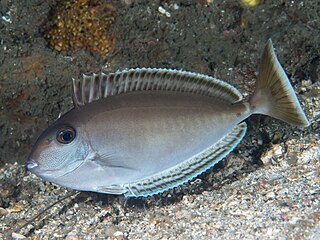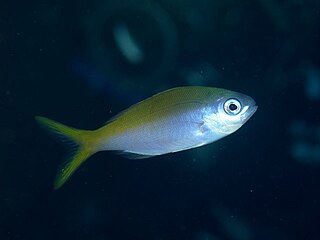
The tentacled flathead, also known as the Indian Ocean crocodilefish, Madagascar flathead or longhead flathead, is a species of marine ray-finned fish belonging to the family Platycephalidae, the flatheads. This species is in the western Indian Ocean, including the Red Sea and the Mediterranean, having invaded as a Lessepsian migrant through the Suez Canal. It is the only species in the monotypic genus Papilloculiceps.

The damba is a species of cichlid.
The whitelined toadfish is a species of fish in the family Batrachoididae. It is endemic to Belize. The specific name honours David W. Greenfield and Teresa Arambula Greenfield, who when they collected type specimen thought that it might belong to an undescribed species and so sent it to Bruce Baden Collette to be described.

Pterois mombasae, the African lionfish, deepwater firefish or frillfin turkeyfish, is a species of marine ray-finned fish belonging to the family Scorpaenidae, the scorpionfishes and lionfishes. It is found in the tropical Indian Ocean, typically in soft-bottomed areas of the ocean, often in conjunction with invertebrate growth. It grows to a maximum size of 20 cm, and is of moderate commercial value.

Cantherhines dumerilii is a species of fish in the family Monacanthidae, the filefishes. Its common names include whitespotted filefish, barred filefish, orange-fin file, and yelloweye leatherjacket. It is distributed in the Indian and Pacific Oceans where it is found on coral reefs.

The longnose hawkfish is a species of marine ray-finned fish, a hawkfish belonging to the family Cirrhitidae. It is found on tropical reefs of the Indian Ocean and the Pacific Ocean, where it can be found at depths around 10 to 100 m. It prefers the steep outer slopes of the reefs amongst gorgonians and black corals. This species can reach 13 cm (5.1 in) in total length. It can also be found in the aquarium trade. It is currently the only known member in its genus.

The yellowback fusilier is a pelagic marine ray-finned fish, a fusilier belonging to the family Caesionidae. It is native to the tropical Indo-Pacific, being found in shallow water from the East African coast to Indonesia.

Naso lopezi, the elongated unicornfish, slender unicornfish or Lopez' unicornfish, is a species of marine ray-finned fish belonging to the family Acanthuridae, the surgeon fishes, unicornfishes and tangs. This species is found in the western Pacific Ocean.

Acanthurus albipectoralis, the whitefin surgeonfish, is a species of marine ray-finned fish belonging to the family Acanthuridae, the surgeonfishes, unicornfishes and tangs. This species is found in the Western Pacific Ocean.

The gold-band fusilier also known as the yellow-band fusilier or black-tipped fusilier, is a species of marine ray-finned fish, a fusilier belonging to the family Caesionidae. It is widespread around reefs in the Indo-West Pacific region.

The squarenose unicornfish is a species of marine ray-finned fish belonging to the family Acanthuridae, the surgeonfishes, unicornfishes and tangs. This species is found in the Indo-Pacific region.
Ecsenius collettei, known commonly as the Collete's blenny in Papua New Guinea, is a species of combtooth blenny in the genus Ecsenius. It is found in coral reefs in the western central Pacific ocean, specifically in Papua New Guinea. It can reach a maximum length of 5 centimetres. The blennies feed primarily off of plants, and benthic algae and weeds. he specific name honours Bruce B. Collette the Director of the National Marine Fisheries Service Systematics Laboratory, whose collection of fish specimens from New Guinea contained a number important blenniid specimens, one of which was this species.
Paraclinus stephensi, the Professor blenny, is a species of labrisomid blenny native to the Pacific coast of Mexico where it can be found at depths of from near the surface to 14 metres (46 ft). The specific name honours the American biologist John S. Stephens Jr., who has extensively studied the Blenniiformes.

Centropyge multispinis, known by the common names bluefin dwarf, brown pygmy angelfish, dusky angelfish, dusky cherub, many-spined angelfish, and multispined angelfish, is a species of marine ray finned fish, a marine angelfish belonging to the family Pomacanthidae. It is found in tropical waters of the Indo-Pacific area.

Colletteichthys is a genus of toadfishes found in the western Indian Ocean. The generic name is a compound of the surname Collette, in honour of the American ichthyologist Bruce Baden Collette to recognise his contribution to the study of toadfish, and the Greek ichthys meaning "fish".
Vladichthys gloverensis is a species of toadfish known only from the Atlantic Coast of Belize and Honduras, where it is found on reefs. This species grows to a standard length of 5.6 cm (2.2 in). The generic name honours the toadfish expert Vladimir "Vlad" Walters (1927-1987) while the specific name denotes Glover's Reef in Belize.

The stargazing stonefish is a species of stonefish native to the Indian Ocean and the western Pacific Ocean where it is found on muddy bottoms in estuaries. This venomous species is also a minor component of local commercial fisheries. This species grows to a length of 8 centimetres (3.1 in) SL. This species is the only known member of the genus Trachicephalus.

Richardsonichthys, is a monotypic genus of marine ray-finned fish belonging to the subfamily Tetraroginae, the waspfishes, which is classified as part of the family Scorpaenidae, the scorpionfishes and their relatives. The only species in the genus is the whiteface waspfish, also known as the whitebelly roguefish, rouge fish, Torres Strait soldier fish or Richardson's waspfish. This species is native to reefs of the Indian Ocean and the western Pacific Ocean.

Paracaesio xanthura, the yellowtail blue snapper, the false fusilier, gold-backed fusilier, Pedley's fusilier or Southern fusilier, is a species of marine ray-finned fish, a snapper belonging to the family Lutjanidae. It is native to the Indo-Pacific region.
The toadfish goby is a species of bony fish in the family Gobiidae which is found in areas of sandy substrates among coral reefs. It occurs in the western Atlantic Ocean from the Bahamas south through the Caribbean Sea as well as along the Central and South American coast from Belize to Santa Marta, Colombia. It is the only species in the monotypic genus Cryptopsilotris, although it was formerly classified under Psilotris and its generic name means "hidden Pilotris", meaning that it was hidden within that genus.
















